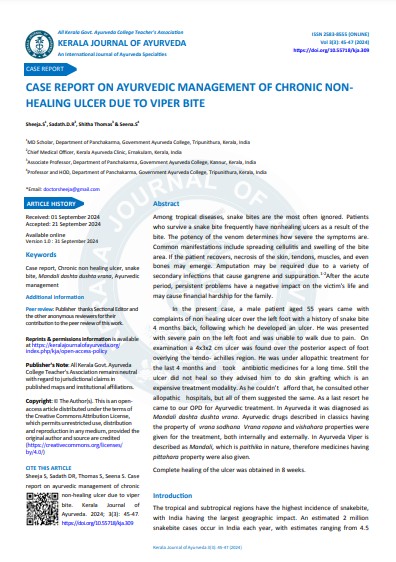CASE REPORT ON AYURVEDIC MANAGEMENT OF CHRONIC NONHEALING ULCER DUE TO VIPER BITE
DOI:
https://doi.org/10.55718/kja.309Keywords:
Case report, Chronic non healing ulcer, snake bite, Mandali dashta dushta vrana, Ayurvedic managementAbstract
Among tropical diseases, snake bites are the most often ignored. Patients who survive a snake bite frequently have nonhealing ulcers as a result of the bite. The potency of the venom determines how severe the symptoms are. Common manifestations include spreading cellulitis and swelling of the bite area. If the patient recovers, necrosis of the skin, tendons, muscles, and even bones may emerge. Amputation may be required due to a variety of secondary infections that cause gangrene and suppuration.1-2 After the acute period, persistent problems have a negative impact on the victim's life and may cause financial hardship for the family.
In the present case, a male patient aged 55 years came with complaints of non healing ulcer over the left foot with a history of snake bite 4 months back, following which he developed an ulcer. He was presented with severe pain on the left foot and was unable to walk due to pain. On examination a 4x3x2 cm ulcer was found over the posterior aspect of foot overlying the tendo- achilles region. He was under allopathic treatment for the last 4 months and took antibiotic medicines for a long time. Still the ulcer did not heal so they advised him to do skin grafting which is an expensive treatment modality. As he couldn’t afford that, he consulted other allopathic hospitals, but all of them suggested the same. As a last resort he came to our OPD for Ayurvedic treatment. In Ayurveda it was diagnosed as Mandali dashta dushta vrana. Ayurvedic drugs described in classics having the property of vrana sodhana Vrana ropana and vishahara properties were given for the treatment, both internally and externally. In Ayurveda Viper is described as Mandali, which is paithika in nature, therefore medicines having pittahara property were also given.
Complete healing of the ulcer was obtained in 8 weeks.
References
https://www.hmpgloballearningnetwork.com/site/wounds/ article/simple-and-effective-approach-treating-non-healingulcers-after-snakebite
Narayan KS. The Essentials of Forensic Medicine and Toxicology. 4th ed. Hyderabad: K. Saguna Devi; 2005:474-81. 2. Guharaj PV. Forensic Medicine. Madras: Orient Longman; 1982:414-28.
http://www.who.int/snakebite/epidemiology/en/
Kularatne SA, Sivansuthan S, Medagedara SC, Maduwage K, de Silva A. Revisiting saw-scaled viper (Echis carinatus) bites in the Jaffna Peninsula of Sri Lanka: distribution, epidemiology and clinical manifestations. Trans R Soc Trop Med Hyg. 2011;105 (10):591-97. *PubMed+ *Google Scholar+
Ariaratnam CA, Thuraisingam V, Kularatne SA, et al. Frequent and potentially fatal envenoming by hump-nosed pit vipers (Hypnale hypnale and H. nepa) in Sri Lanka: lack of effective antivenom. Trans R Soc Trop Med Hyg. 2008;102(11):1120-126. *PubMed+ *Google Scholar+
Weatherall DJ, Ledingham JGG, Warrell DA, editors. 3rd ed. I. Oxford Medical Publications; 1996. Injuries, envenoming, poisoning, and allergic reactions caused by animals; 1126-139. (Oxford Textbook of Medicine). *Google Scholar+
Reid HA, Theakston RBG. The Management of Snakebite. Bull of WHO. 1983;61(6):885-95. *PMC free article+ *PubMed+ *Google Scholar+
Astanga Sangrah, uttarsthana, 41/49-51 Chaukhamba Orientalia, Varanassi, Reprint, 2012





